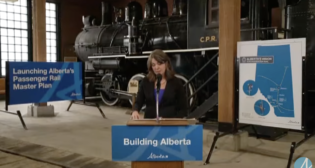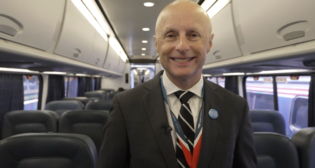
Safety : Merging survival and avoidance approaches
Written by AdministratorMost global passenger rail suppliers accept a basic schism in their marketplace: Europe and most of Asia seek passenger designs based on crash avoidance. U.S. counterparts had to meet crash survivability priorities.
“Build a tank,”one rail supplier executive says to Railway Age, outlining his take on the historical U.S. approach to rail safety, which he largely attributed to the Federal Railroad Administration. “Acela, intercity rail, commuter rail, subway, light rail—build them all to withstand the worst; hang the weight, and hang the resultant cost.”
The tissue-paper-thin veil of resentment is hardly universal, but neither is it rare. And for many it has an identifiable “flashpoint”: Austin, Tex.’s struggle to establish its MetroRail service. Between 2006 and 2008, Austin’s Capital Metropolitan Transportation Authority sought to have its 32-mile line identified as a diesel light-rail transit (DLRT) or “light railway” operation. CapMetro judged its fleet of six Stadler-Bussnag diesel units, with temporal (time-of-day) separation from potential freight traffic conflicts, adequately protected.
But FRA found that the “operations … constitute a commuter rail system” and thus were subject to FRA oversight when it came to safety standards. Moreover, FRA’s oversight, approved by Congress, expanded significantly to include more urban transit operations under a joint statement issue by FRA and the Federal Transit Administration on July 10, 2000.
HSR: Catalyst for evolving approach
Others, however, say the caricature of FRA wearing the black hat is unfair—or at least dated—particularly as FRA helps guide the latest U.S. efforts to implement high speed rail, in hopes of avoiding the failed efforts of a decade ago.
“European gear has been eyed for use in the U.S. since at least the Florida Overland eXpress (FOX) effort,” which began in 1996 says Paul Larouche, Bombardier Transportation director of product planning. The project, terminated early this year by Fla. Gov. Rick Scott, had struggled with other issues, including equipment standards, until very recently. “This has been one of the big dampers on (U.S.) high speed rail in general, the uncertainty” of the rules that would apply, Larouche asserts. But Larouche says it is “unfair” to describe FRA as over-reliant on crash survival, as opposed to crash avoidance. Larouche noted that FRA’s efforts to eliminate grade crossings are “an example of ‘avoidance’”—and that the search for a reasonable approach to U.S. high speed rail similarly seeks some focus on avoidance, not just survivability.
Larouche points to “the big success” of Engineering Task Force 1, which late last year agreed on standards for passenger rail equipment designed for speeds of up to 125 mph (ETF1 Tier 1) and for mixed service for speeds up to 150 mph (EFT1 Tier 2). (The Federal Railroad Administration is due to release its report and recommendations shortly.)
The American Public Transportation Association’s (APTA) Rail Safety Advisory Committee, including carbuilders, rail transit agencies, and Amtrak, has worked to address HSR safety issues involving not just equipment, but also issues of old and new infrastructure, including existing rail terminals, which (Larouche notes) are likely to be the stations of choice for any U.S. HSR effort.
One pleasant surprise: Rail gear designed to meet European specifications showed crash energy management performance “similar”—and “not inferior”—to comparable gear built for North America.
The next step is to agree on EFT2 standards, which would apply crash safety standards to dedicated HSR between 125 mph and 220 mph. Here, the focus almost has to be on crash avoidance, Larouche says, and not just because of the higher speeds involved.
“The issues of crashworthiness, or crash avoidance, may be more critical for high speed rail on the approaches to stations, shared with more conventional rail service, than it might be at top speeds on dedicated high speed rail right-of-way,” Larouche says.
Transit transition
In terms of urban transit vehicles, differences remain. At the APTA Rail Conference in Boston last month, Bombardier Senior Specialist Jacques Drouin, reviewing Bombardier’s massive two-pronged light rail transit contract with Toronto (204 cars and 182 cars), noted the Flexity vehicles required by Canada’s largest city included “structural changes to accommodate different compressive loads and different crash absorption” relative to European Flexity models.
Other differences, specifically involving the U.S. if not Canada, included continental variances on fire suppression, weather resistance (based on a perception that North America’s weather, particularly winter, is harsher than Europe’s), and American with Disabilities Act (ADA) requirements.
“When we review the designs from the various authorities, we monitor for existing guidelines and specs,” says STV, Inc. Senior Associate and Project Manager Norman Szala. He allows that the standards are pretty rigorous, and weighted toward crashworthiness—the performance of a rail vehicle in an accident, including crumple zones, and the resultant survival of the vehicle’s occupants. Federal standards per CFR Part 238 “were revised recently to come up to speed with APTA standards, which were ahead of CFT,” making STV’s job a little easier, Szala says.
For Siemens Mobility, one option was to establish a North American operating base to serve the U.S. and Canadian market, then stay even with or ahead of whatever regulatory changes came along. Siemens U2 cars, largely based on European designs, were chosen for San Diego’s initial light rail line, which opened in 1981, making it the U.S. city to commit to “modern” light rail transit.
“We’ve been in the market for 30 years, and first adapted our designs to U.S. standards; we now have designs specifically for the U.S.,” says Siemens Mobility Vice President, Business Development Robin Stimson.
Stimson also sees a trend toward melding the advantages of crashworthiness and crash avoidance in rapid and urban transit vehicles, similar to the trend seen by Bombardier’s Larouche for high speed rail. “We’ve been involved in the discussions,” he says. Stimson acknowledges the requirement for heavier, “stiffer” U.S. transit vehicles has exacted a fiscal (and energy) penalty, but he believes there’s now “a new movement toward crash energy management and crash avoidance. It’s really a blend. Our product behaves very well domestically [the U.S. market]. But we’ve been part of the working groups, with include the FRA, to modify the requirements.”
But other industry sources observe that a focus on crash avoidance already is in place for U.S. transit agencies, and that installation of Positive Train Control (cost/benefit ratios aside) will give regional and intercity rail operators “a higher level of safety.”
Bombardier’s Larouche concurs, noting recent FRA efforts to accommodate diesel light rail transit (DLRT) operations in New Jersey (the RiverLINE) and California (Sprinter). “We might see more ‘Stadler DMUs in Denton County’ scenarios,” he says, citing the pending debut of service in Denton County, Tex., this month, which includes shared right-of-way (though not shared track) with Dallas Area Rapid Transit’s lighter-weight light rail vehicles.
Here, too, FRA has shown a willingness to address crash avoidance.
Working with New Jersey Transit, for example, the agency has allowed NJT’s RiverLINE to adjust temporal separation (time-of-day) operations to allow more flexibility for both DLRT and freight rail operations, sometimes after a simple infrastructure addition such as a siding or new switch.
Indeed, North American transit properties may provide more near-term impetus to merge crashworthiness and crash avoidance than HSR, due more to fiscal commitment than to safety issues themselves.
Federal budget woes may limit or eliminate appropriations for Amtrak, and cut off the flow of HSR funding already in the pipeline.
But numerous urban transit projects, backed by large percentages of local, regional, state, and/or private funding, continue to move forward. “It’s going to happen” was a phrase offered more than once at the APTA Rail Conference in Boston last month, referring to rail transit developments in Honolulu, Cincinnati, Fort Worth, Tex., and West Sacramento, Calif.



